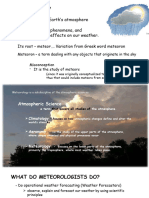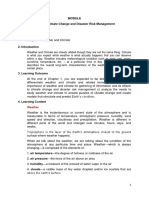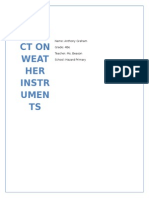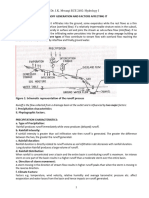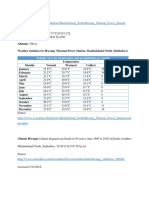Meteorology
Meteorology
Uploaded by
GM MostakimCopyright:
Available Formats
Meteorology
Meteorology
Uploaded by
GM MostakimCopyright
Available Formats
Share this document
Did you find this document useful?
Is this content inappropriate?
Copyright:
Available Formats
Meteorology
Meteorology
Uploaded by
GM MostakimCopyright:
Available Formats
Meteorology concerns itself with the science of atmospheric properties and
phenomena—a science that includes the atmosphere's physics and chemistry.
Meteorologists are often thought of as people who forecast the weather.
Meteorology is the branch of science concerned with the processes and
phenomena of the atmosphere and atmospheric effects on our
weather., especially as a means of forecasting the weather. The atmosphere is the gaseous
layer of the physical environment that surrounds a planet.
Meteorology is the science of the atmosphere concerned with the physical,
dynamic, and chemical state of the earth's atmosphere.
Meteorology is the study of the atmosphere and motions within the atmosphere
on short-time scales
What will I learn?
When we do, our immediate thought is to its usefulness in predicting the weather. Yet it
covers all aspects of the atmosphere, including atmospheric physics and chemistry.
• an induction course to learn basic meteorology.
Basic principles of atmospheric science and weather forecasting
• The broad range of weather and warning services delivered by the Bureau, and how
you can use these to make better, more informed decisions
Why is it called meteorology?
The term Meteorology has quite a history deriving from the Greek word meteoron, which
more or less meant “something in the sky.” Around 340 BC, the famous philosopher
Aristotle wrote a treatise called Meteorologica, a work covering the totality of that era's
knowledge of weather and climate.
However, the man many consider to be the “Father of Meteorology” is an Englishman
named Luke Howard. In the early 1800s, Luke Howard recorded detailed observations
of weather in and around London. His comprehensive work laid the groundwork for the
understanding of how weather works and offered suggestions as to why.
Meteorology Fields
Weather Forecasting and Warnings. ...
Atmospheric Research. ...
Meteorological Technology Development and Support. ...
Information Services. ...
Forensic Services. ...
Broadcast Meteorology. ...
Teaching.
What is meteorology and its branches?
Meteorology deals with the specific weather conditions at a given time and place, while
climatology is concerned with average weather conditions over extended periods of time
and in areas all over the globe. Synoptic and dynamic meteorology are two major
branches of meteorology.
What is another word for meteorology?
weather casting, weather forecasting
weather prediction aerology
climatology atmospheric chemistry
atmospheric physics atmospheric science
weather science
Observational data collected by doppler radar, radiosondes, weather satellites, buoys,
and other instruments are fed into computerized NWS numerical forecast models. The
models use equations, along with new and past weather data, to provide forecast
guidance to our meteorologists.
Meteorological instruments (or weather instruments), which include meteorological
sensors (weather sensors), are used to determine the state of the atmosphere at a
given time. Rain gauges are useful for measuring precipitation. Thermometers are used
to measure the temperature outside.
AnemometerAn instrument that measures the wind speed.
Wind Vane : It tells the direction of the wind.Sling PsychrometerIt measures the relative
humidity.ThermometerIt measures the air temperature. When air around the tube heats
up the liquid (of mercury or alcohol), the liquid rises up and that tube estimates the
actual temperature.Hygrometer An instrument to measure the humidity of the air.Rain
GaugeIt measures the amount of rain fallen over a time-period.Weather BalloonIt
measures the weather conditions high up in the atmosphere.Weather SatellitesIt
captures photographs to track large-scale air motions taking place over the Earth’s
surface from space.BarometerUsed by meteorologists to measure air pressure.When
the barometer readings rise up, it indicates dry and sunny weather.When the barometer
readings fall, it indicates rain and stormy weather.Weather Maps It shows the
atmospheric conditions over a large portion of the Earth’s surface.The weather
measurements are formatted in special format and transmitted to WMO (World
Meteorological Organization) to help the weather forecast model.Importance of Weather
Recording
An anemometer is an instrument that measures wind speed and wind pressure.
Anemometers are important tools for meteorologists, who study weather patterns.
What are the 7 elements of weather?
The basic atmospheric conditions that make up the weather include precipitation,
humidity, temperature, pressure, cloudiness, and wind. The air is constantly in
motion. There also is a continuous exchange of heat and moisture between the
atmosphere and Earth's land and sea surfaces.
Meteorological elements include temperature, pressure, humidity, wind direction and
speed, radiation, and phenomena (clouds, precipitation, thunderstorms, fog,
snowstorms, etc.). The changes in the meteorological elements are the result of
atmospheric processes, which in turn determine the weather and climate.
There are nine main elements or components (or parts) of weather that are discussed
below: Temperature Wind velocity and direction Humidity Rainfall Snow Cloud
formation Sunshine Thunder Lightning
Atmospheric pressureCloudinessTopographySolar irradiance
(sunshine)HumidityPrecipitation
Precipitation (It Could be rain, hail, sleet or snow)
Who is called a meteorologist?
A meteorologist is an individual with specialized education who uses scientific principles
to explain, understand, observe or forecast the earth's atmospheric phenomena and/or
how the atmosphere affects the earth and life on the planet.
You might also like
- Module of ClimateDocument153 pagesModule of ClimateAddaa WondimeNo ratings yet
- Meteorology Key PointsDocument4 pagesMeteorology Key PointsMichael Angelo Dela CruzNo ratings yet
- Weather Tools PPTDocument23 pagesWeather Tools PPTconwenaNo ratings yet
- MeteorologyDocument2 pagesMeteorologyIoniță AndreeaNo ratings yet
- Introduction and History of MeteorologyDocument16 pagesIntroduction and History of MeteorologyJess RadañaNo ratings yet
- Meteorology: Introduction ToDocument34 pagesMeteorology: Introduction ToAndrea FameroNo ratings yet
- Astronomy and MeteorologyDocument24 pagesAstronomy and MeteorologyJeko Betguen PalangiNo ratings yet
- Introduction To MeteorologyDocument16 pagesIntroduction To MeteorologyJessa CalambaNo ratings yet
- Geography DraftDocument11 pagesGeography Drafts.suchitra1026No ratings yet
- Meteorology by Coleman and LawDocument7 pagesMeteorology by Coleman and LawAliah MosqueraNo ratings yet
- Lecture 1 SlidesDocument43 pagesLecture 1 Slidesisootaisaac6No ratings yet
- Unit 1Document4 pagesUnit 1bhonkarapurvaNo ratings yet
- Introduction To Climate (Module)Document68 pagesIntroduction To Climate (Module)Adimasu TafesseNo ratings yet
- Explain The Scope of Climatology and Elucidate The Roll of ClimatologistDocument8 pagesExplain The Scope of Climatology and Elucidate The Roll of ClimatologistAmaya InduwaraniNo ratings yet
- Geography HYDocument5 pagesGeography HYArpit BarmanNo ratings yet
- Weather InstrumentsDocument12 pagesWeather InstrumentsMisha WilliamsNo ratings yet
- Weather Instrument PDFDocument7 pagesWeather Instrument PDFjs cyberzoneNo ratings yet
- Elements of Weather and ClimateDocument6 pagesElements of Weather and ClimateFarheen BanoNo ratings yet
- Topic 1 MeteorologyDocument24 pagesTopic 1 MeteorologySalih TrexieNo ratings yet
- Introduction To Met-O2Document64 pagesIntroduction To Met-O2Leo Keith JocsonNo ratings yet
- Module For Climate Change Chapter 1 - Weather and ClimateDocument12 pagesModule For Climate Change Chapter 1 - Weather and ClimateKurt Morin CantorNo ratings yet
- E-Journal in MeteorologyDocument10 pagesE-Journal in MeteorologycuthNo ratings yet
- Weather and ClimateDocument67 pagesWeather and ClimateanashemupinduNo ratings yet
- GPSCDocument13 pagesGPSCyashsariya25No ratings yet
- Meteorology and ClimatolodyDocument7 pagesMeteorology and ClimatolodySylvia Sinda100% (1)
- Chapter 1 Weather and ClimateDocument15 pagesChapter 1 Weather and ClimateZaza Red-eyedNo ratings yet
- Meteorological Instruments and Their UsesDocument22 pagesMeteorological Instruments and Their UsesYuvan89% (37)
- 2 MeteorologyDocument93 pages2 MeteorologyMiho BoskovicNo ratings yet
- Chapter 1 Weather and ClimateDocument11 pagesChapter 1 Weather and ClimateCathleen Delacruz BaptistaNo ratings yet
- Anthony Graham's ProjectDocument7 pagesAnthony Graham's ProjectromiifreeNo ratings yet
- Meteorology GNU Free Documentation LicenseDocument18 pagesMeteorology GNU Free Documentation LicenseEdbert TulipasNo ratings yet
- Weather Forecast and InstrumentsDocument9 pagesWeather Forecast and InstrumentsKayPasionNo ratings yet
- Interactive Textbook 2 4 Forcasting The Weather16Document5 pagesInteractive Textbook 2 4 Forcasting The Weather16api-240094705No ratings yet
- Weather InsDocument13 pagesWeather Insroxanne.paconNo ratings yet
- 303 Climatology: Nazmun NaharDocument76 pages303 Climatology: Nazmun NaharProf. Vandana Tiwari SrivastavaNo ratings yet
- Weather analysis and forecastingDocument14 pagesWeather analysis and forecastingDilraj KandirNo ratings yet
- ClimatologyDocument26 pagesClimatologydjoatessNo ratings yet
- Met-O 1 Prelim DiscussionDocument37 pagesMet-O 1 Prelim DiscussionJONATHAN LOGOC100% (3)
- Rough Draft: Geography ProjectDocument3 pagesRough Draft: Geography ProjectPushpajaNo ratings yet
- Met O WK 1-4Document29 pagesMet O WK 1-4reoverosjonathan1No ratings yet
- Weather PrakharDocument8 pagesWeather PrakharpragyansrivastavahawkingNo ratings yet
- Basic Concepts of MeteorologyDocument12 pagesBasic Concepts of MeteorologytwinkleNo ratings yet
- Nature and Scope of ClimatologyDocument7 pagesNature and Scope of Climatologymstluangapachuau19No ratings yet
- MeteorologyDocument42 pagesMeteorologyJeselia Sunico ArsagaNo ratings yet
- Module 2 Weather - HandoutsDocument57 pagesModule 2 Weather - HandoutsJaycee Silveo Seran100% (1)
- What Are The Uses of Meteorological InstrumentsDocument2 pagesWhat Are The Uses of Meteorological InstrumentsCire DuronNo ratings yet
- Ishmael - Calanoga, v.Document16 pagesIshmael - Calanoga, v.VJ CalanogaNo ratings yet
- Activity 3 Weather and ClimateDocument7 pagesActivity 3 Weather and ClimateJR ParkNo ratings yet
- Agri MeteorologyDocument84 pagesAgri MeteorologysusheelNo ratings yet
- How A Weather Forecast Is MadeDocument2 pagesHow A Weather Forecast Is MadeCy Ber Allen CubonNo ratings yet
- Science 4 Q4 W4 Day 1 4 1Document76 pagesScience 4 Q4 W4 Day 1 4 1LigieNo ratings yet
- Meteorological Instruments: Hamza Mohammad - 2014-Civ-206 - 28-Sep-2016Document7 pagesMeteorological Instruments: Hamza Mohammad - 2014-Civ-206 - 28-Sep-2016mahmoud6y.6al6issawyNo ratings yet
- The Atmosphere: Ma. Salve T. AntaranDocument84 pagesThe Atmosphere: Ma. Salve T. AntaranFlora Mae Masangcay DailisanNo ratings yet
- MeteorologyDocument8 pagesMeteorologyDeane Marc TorioNo ratings yet
- Metreology IntroductionDocument55 pagesMetreology IntroductionAlexandra Dela CruzNo ratings yet
- Module 1 MeteorologyDocument6 pagesModule 1 MeteorologyRealyn FababaerNo ratings yet
- Climatology: Jump To Navigationjump To SearchDocument11 pagesClimatology: Jump To Navigationjump To SearchLali HajzeriNo ratings yet
- Field Guide to the Weather: Learn to Identify Clouds and Storms, Forecast the Weather, and Stay SafeFrom EverandField Guide to the Weather: Learn to Identify Clouds and Storms, Forecast the Weather, and Stay SafeNo ratings yet
- The Weather of the Future: Heat Waves, Extreme Storms, and Other Scenes from a Climate-Changed PlanetFrom EverandThe Weather of the Future: Heat Waves, Extreme Storms, and Other Scenes from a Climate-Changed PlanetNo ratings yet
- Geography P1 Nov 2023 EngDocument19 pagesGeography P1 Nov 2023 Engbenjaminlocke2.1No ratings yet
- Shs - drrm11-12 - q2 - Mod2 - Hydrometeorological HazardDocument19 pagesShs - drrm11-12 - q2 - Mod2 - Hydrometeorological HazardAlhzene PanesNo ratings yet
- Quiz No.1 in CE 412 - Hydrology: Biliran Province State University School of EngineeringDocument2 pagesQuiz No.1 in CE 412 - Hydrology: Biliran Province State University School of Engineeringwendy ponsicaNo ratings yet
- First Session of NPDRRDocument359 pagesFirst Session of NPDRRHansen Thambi PremNo ratings yet
- Engineering HydrologyDocument8 pagesEngineering HydrologyErald EnriquezNo ratings yet
- Impacts of Climate Change On Tea Production in AssamDocument10 pagesImpacts of Climate Change On Tea Production in Assamvihaan chaudharyNo ratings yet
- Climate of SomaliaDocument82 pagesClimate of SomaliaJayabalan R KNo ratings yet
- Map It! WorkbookDocument46 pagesMap It! WorkbookToni Krasnic100% (5)
- Bangladesh: Geographical & Environmental Settings-Location, Climate, River Systems, and Floods in BangladeshDocument94 pagesBangladesh: Geographical & Environmental Settings-Location, Climate, River Systems, and Floods in BangladeshMeherun Islam TitoNo ratings yet
- BOE 2021 Climate Scenarios - Financial-RisksDocument50 pagesBOE 2021 Climate Scenarios - Financial-RisksKrit YodpraditNo ratings yet
- Disaster Response and Risk Reduction: Philippine Central Islands College San Jose, Occidental MindoroDocument17 pagesDisaster Response and Risk Reduction: Philippine Central Islands College San Jose, Occidental MindoroQuijano, Stephanie L.No ratings yet
- Lecture 7Document18 pagesLecture 7Muhammad sheryarNo ratings yet
- Stream FlowDocument23 pagesStream FlowEmmanuel AtakosNo ratings yet
- Lecture 2 NotesDocument13 pagesLecture 2 Notesonesmus AnyimuNo ratings yet
- TUNISIADocument20 pagesTUNISIAala garbeyNo ratings yet
- The Water Cycle WorksheetsDocument9 pagesThe Water Cycle Worksheetsafifa.mdatbm00No ratings yet
- Geography and WeatherDocument4 pagesGeography and WeatherStephen SmithNo ratings yet
- A20 - T-N - U1 - l4 - Ipa UmbrellasDocument2 pagesA20 - T-N - U1 - l4 - Ipa UmbrellasHoàng Phương LinhNo ratings yet
- Grade 8 Geo Sba Term 2 2023Document6 pagesGrade 8 Geo Sba Term 2 2023Thuli BhenguNo ratings yet
- Modelling Climate and Societal ResiliencDocument17 pagesModelling Climate and Societal ResilienccctNo ratings yet
- RAINFALL ... HandoutsDocument10 pagesRAINFALL ... Handoutsareeb9187No ratings yet
- Class 12 English Chapter Wise ExplanationDocument9 pagesClass 12 English Chapter Wise ExplanationMd Farhan AnisNo ratings yet
- Appendix Climatic DataDocument5 pagesAppendix Climatic DataLovemore MalakiNo ratings yet
- A6 SimeonovDocument6 pagesA6 SimeonovkshazadNo ratings yet
- Climate Change and Vulnerability: A Nepalese ScenarioDocument114 pagesClimate Change and Vulnerability: A Nepalese ScenarioKanchan Mani DixitNo ratings yet
- Sediment Production and Water Quality of Watersheds With Contrasting Land Use in Navarre (Spain)Document12 pagesSediment Production and Water Quality of Watersheds With Contrasting Land Use in Navarre (Spain)krismanNo ratings yet
- Catchment Calibration With CommentsDocument65 pagesCatchment Calibration With CommentsLuis OsegueraNo ratings yet
- Learning Activity Sheets Science: Quarter 3 - Week 5&6Document10 pagesLearning Activity Sheets Science: Quarter 3 - Week 5&6soobacadoNo ratings yet
- To Study Effect of Drought On Coriander (Coriandrum Sativum) For Morpho-Physiological TraitsDocument67 pagesTo Study Effect of Drought On Coriander (Coriandrum Sativum) For Morpho-Physiological TraitsrahulNo ratings yet
- đề thi giữa kỳ 01-đáp án tự luậnDocument7 pagesđề thi giữa kỳ 01-đáp án tự luậnmailephuquang01No ratings yet




